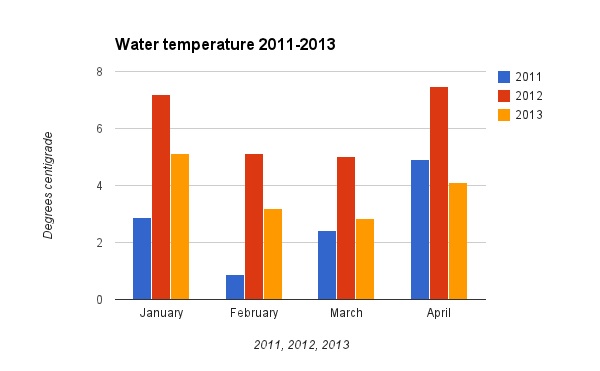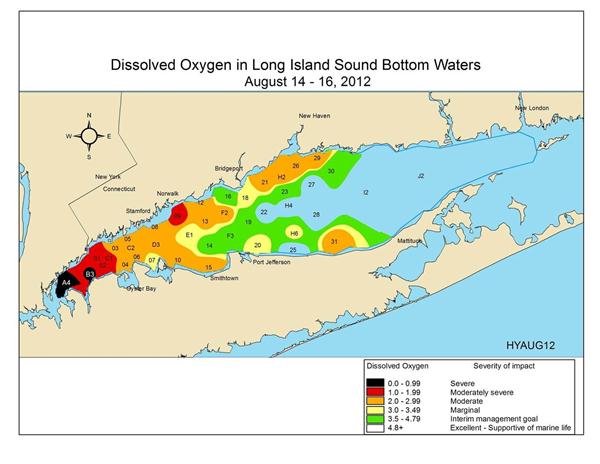The dead zone in western Long Island Sound is triggered primarily by excess nitrogen found in sewage discharges and stormwater runoff, but water temperatures play a big role too.
Last year, temperatures were among the highest ever recorded for the Sound, and dissolved oxygen levels were unusually low. The year before was colder, and hypoxia was limited.
So what will 2013 bring? It may be impossible to say but it’s interesting to speculate. Water temperatures in 2013 have been cooler than in 2012 but not as cold as 2011. That might mean that the western end of the Sound will be spared the brutal conditions of last August, but may be worse than the summer of 2011, especially given the extra nitrogen that found its way into the system during Hurricane Sandy.

Hypoxia occurs in summer when nitrogen, from treated sewage, combined sewer overflows and stormwater, as well as acid rain and other sources, fertilizes the Sound’s algae, which use the oxygen in the water when they die and decompose.
Normally, dissolved oxygen concentrations should be about 8 milligrams per liter, falling perhaps to 5 mg/l in summer.
But in the western end of the Sound, dissolved oxygen often falls below 3 mg/l, a level that results in a 40 percent reduction in fish. When concentrations fall below 2 mg/l, the reduction in fish is 88 percent. And when they fall below 1 mg/l, the drop is total – there are no fish.
That last situation was rare in recent years. In 2007, 2009, 2010 and 2011 dissolved oxygen concentrations were above 1 mg/l everywhere in Long Island Sound, which is why last year’s low levels were so surprising.
In 2012, more than 20 percent of the Sound (about 288 square miles) had concentrations below 3 mg/l in August, making it the fourth worst year since 1991. Sixty-seven square miles were below 2 mg/l, and 18 square miles, off Westchester and Nassau counties, were below 1 mg/l. You can find more details in this previous post.
 In an effort to restore the Sound, sewage treatment plants are being upgraded, with a goal of a 58.5 percent nitrogen reduction by 2014-2017. And while overall we’re making progress, New York City, Westchester and Nassau counties have substantial work ahead of them.
In an effort to restore the Sound, sewage treatment plants are being upgraded, with a goal of a 58.5 percent nitrogen reduction by 2014-2017. And while overall we’re making progress, New York City, Westchester and Nassau counties have substantial work ahead of them.
Save the Sound is advocating for federal and state funding so municipalities can make the necessary investments but we are also ensuring that treatment plant operators meet their mandatory deadlines for upgrades.
In the meantime, there’s water temperature to think about, both short-term variations and longer-term climate changes.
The Connecticut Department of Energy and Environmental Protection makes twice-monthly research cruises along the Sound, recording water temperatures and other water quality measurements.
Consider this data: on nine of the first 16 cruises in winter and early spring of 2012, the maximum recorded temperature was the highest in 21 years. The minimum recorded temperature was the highest in 21 years on 15 occasions. The average temperature on those 16 research trips in 2012 was the highest in 21 years on 11 occasions.
In other words, Long Island Sound was unusually warm in 2012 and it did not cool off as much as in the past.
By contrast, 2011 was much colder and 2013 has been somewhat colder.
Here are the bottom temperatures, in centigrade, recorded in the first four months of the last three years:
January
2011 – 2.89 degrees. 2012 – 7.21 degrees. 2013 – 5.18 degrees
February
2011 – 0.88 degrees. 2012 – 5.13 degrees. 2013 – 3.21 degrees
March
2011 – 2.41 degrees. 2012 – 5.02 degrees. 2013 – 2.83 degrees
April
2011 – 4.92 degrees. 2012 – 7.49 degrees. 2013 – 4.11 degrees
All things being equal, we hope the cooler temperatures will make hypoxia considerably less severe this summer.
Over the long-term, it’s worth noting that researchers believe the Sound has been growing warmer, in part due to climate change. They also predict a potential lag between when the nitrogen reduction goal is reached (in 2014-2017) and water quality improves. That lag could be five to 10 years.
Until then we need to stay vigilant, stay optimistic and hope that normal variations in weather give us a reprieve.
Posted by Tom Andersen, NY program and communications coordinator for Save the Sound.
